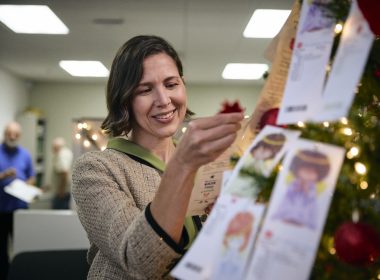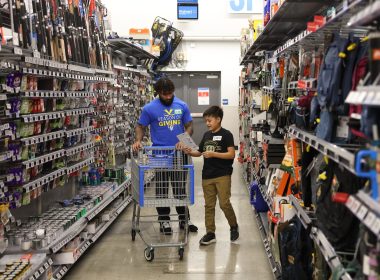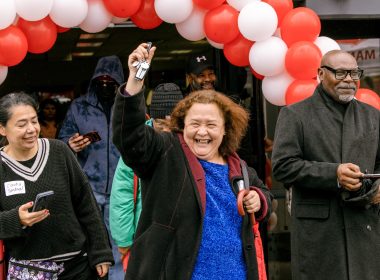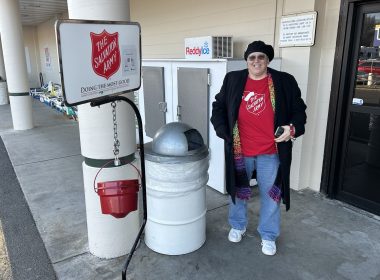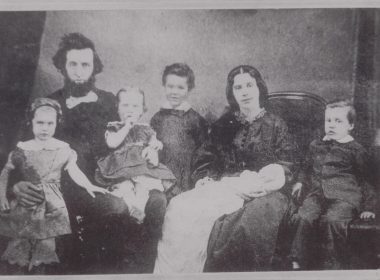Doing the Most Good in Northwest
by Sue Schumann Warner –
Renton Corps Officer Captain Christine Giffey-Brohaugh enjoys a time of prayer and coffee at the food bank. |
The elegant old home sits on a shady, tree-lined street in a residential section of Seattle, Wash.—its serene exterior gives no hint of the turmoil that once filled the lives of the women who live there.
Its official name is the Catherine Booth House, but for those fortunate enough to reside within this confidential emergency shelter for abused women and their children—and receive the help they need in starting a new life free from the fear of physical or emotional violence—this place of safety is simply called, home.
And it is one of the many means by which The Salvation Army’s Northwest Division is doing the most good for those they serve.
Doing the most good
Throughout the division, which includes Washington and parts of Montana and Idaho, the Army is meeting physical, emotional, and spiritual needs of tens of thousands of men, women and children each year. Some examples are:
- Bremerton and Everett, Wash., corps—concern for military families resulted in sending Navy kids to camp and providing a “day out” for moms, watching their children at the corps so mothers can have free time.
- Pasco Temple, Wash.— Home League members visit homes of families who received Christmas baskets and invite them to the corps.
- Helena, Mont.— “Homeless to Homeowner” program helps low income families own their own homes.
- Kalispell, Mont.—a dental and medical clinic at the corps provides services to those in need.
- Centralia, Wash.—a supper club and Hope Share after school program give supervision and support to kids and their families.
A sense of optimism
“We are doing the most good with the services we provide for people who are hurting,” said Divisional Commander Lt. Colonel Harold Brodin. Brodin and his wife, Lt. Colonel Joann Brodin, serve as Northwest divisional leaders. “The quality of our service—the quality that we bring into their lives—is important.”
Lt. Colonel Joann Brodin notes that this is not a “band-aid” approach: “We individualize our work with people; the Army’s distinctive is in bringing their spiritual, physical and emotional needs into proper balance.”
It’s not without its challenges, however.
A region with a pioneering spirit, considered by many to be “the last frontier”—and one of the most unchurched areas in the United States—the Northwest has suffered an economic downswing: the logging industry—once a key factor in its economy—is depressed; and many were affected by the dot com crash of the late 1990s. Consequently, the division has more needs than resources, which means maintaining the quality of services and expanding at the same time is difficult.
According to Brodin, this has been made a little easier by the division’s financial status. “Our financial picture is improving,” he stated. “We’re in the black for this year, although since we are still working off the problems of the past, it’s still pretty tight.”
That improvement started four years ago, said Major John Chamness, divisional secretary for business, when the divisional finance secretary “saw the directions things were going in after [the terrorist attacks on] 9/11 and started to make changes to correct that.” This involved laying off staff and giving each corps or unit additional help in preparing their budgets. This teamwork with the corps has resulted in “a sense of optimism in the field,” said Brodin.
“The corps officers are committed to living within their budgets. We [DHQ] are committed to coming alongside to support them and to stay in budget as well.”
Regenerating Army’s work
Growing healthy corps is not just a key focus of the division, it’s part of the Northwest DHQ’s mission statement: “The Northwest divisional headquarters exists to enable all centers to become healthy, mission-focused expressions of The Salvation Army.”
One new approach to achieving this is in utilizing the Regenerate principles of author Paul Bordon, who has spoken at the division’s officers’ councils.
“We are going back to the Army’s roots—to doing the work of The Salvation Army,” said Chamness. This fall, they started four cluster groups of officers in geographical regions, who gather five times a year to pray, encourage and support each other, receive training, and address problems on the field.
“The status quo is gone,” stated Brodin, simply. “We are for change. We have changed our financial situation, we are serving more people every year, and we are changing the thinking of the corps officers in a lot of ways. Regenerate is about things no longer staying the same—both DHQ and the coprs are changing the way we do business.
“William Booth would have been proud of the things we’re doing in this division. We’re challenging the past, and we’re willing to be on the edge—to try different things, take that step of faith and do a little risk taking.”
And as they do that, the quality they bring to the programs and to the lives of people they serve is a constant reflection of the division’s motivation to do the most good.
Renton food bank builds community
The Renton, Wash., corps’ food bank serves in many ways as an “edible feast,” even before one enters the new $1.58 million building. Outside, Captain Christine Giffey-Brohaugh saw to it that the landscaping was completely planted in produce, including fig trees, Russian plums, Asian pears, blueberries, black currents, herbs and more. “We want to build a sense of community with this facility,” she said, “not a sense of poverty. I hope that in time harvesting this will add to a sense of community, a sense of healing.”
The food bank serves 950 families a month; underlying that is a profound sense of dignity for those they serve. “The way you deliver food has a lot to do with ‘soup, soap and salvation’. William Booth’s three words are still the best description of social service,” she notes. In light of that, food in the distribution center is arranged in food groups, providing a sense of choice for clients, who receive a four-day supply of food.
Toni Esparza is director of the service center, which is completely staffed by volunteers—who again, building a sense of community.
The facility meets other needs as well: a weekend Roto-Care clinic, staffed by volunteer doctors and nurses, provides free medical care, screening and offers referrals if needed.
Seattle’s Social Services
The Salvation Army in Seattle provides a vast array of social services, ranging from the Catherine Booth House and the Hickman House, a transitional housing program for abused women and their children, to the William Booth Center, a shelter for homeless men that provides a number of different transitional living programs.
Major Nila Fankhauser serves as the city’s social services secretary; her husband, Major Larry Fankhauser, is chaplain for the William Booth Center.
Of highest priority is the Army’s ability to maintain a seamless continuum of care for its clients. “It really makes a difference in people’s lives,” said Major Nila Fankhauser.
At the Pike Street facility new spiritual care officers, Majors Roberto and Aurora Otero, provide an added dimension to the program. They pray for those who request it, visit the homeless in hospitals, and are available for listening and talking to those who wish to do so. Major Aurora also conducts a weekly Bible study at the Catherine Booth House (CBH).
Many who take shelter at CBH arrive with only the clothes on their back—the women are met off site and escorted to the confidential shelter after escaping their abuser who may be in jail, at work, or just out of the home for a few minutes. Women can stay from 28 days to three months and receive case management while there. “We try to make it a transition,” said Georgia Gillespie, house manager and administrative assistant, “so it isn’t a time of loss.”
The shelter—the only one in the city that takes mothers and their children—is in dire need of relocating due to the deteriorating state of the facility, which is over 100 years old.
Hickman House is the next step after shelter living for women in their journey to self-sufficiency. Here, women and their children who have suffered abuse can learn to live independently in apartments while gearing up to get a job or go back to school to complete an education. During their average stay of a year and a half, they new skills, and both moms and children receive much-needed support and structure.
Over at William Booth Center, nestled in the shadow of Seattle’s Safeco Stadium, hundreds of homeless men find shelter and new direction in life each year through:
• A transitional program for homeless veterans
• A transitional shelter program
• 50-bed transitional living program, providing a furnished single room and case management for up to two years
• H.O.P.E. program (Homeless Outreach Projects and Evaluation) helps disabled homeless in applying for Social Security disability insurance (SSDI) and supplemental Social Security income (SSI).
More than just “three hots [meals] and a cot,” William Booth Center gives men hope— and the tools they need—to embark upon the road to self-respect and self-sufficiency. Additionally, The Salvation Army operates an Adult Rehabilitation Center within the city of Seattle, with referrals from other communities, that served 583 men and 56 women last year. The Army’s ARC program will be reported on fully in a future issue of New Frontier.
Doing the most good? In the Northwest Division, it hinges on quality of programs, services and ministry…and, of course, the quality of change in the lives of those they serve.

